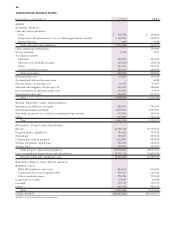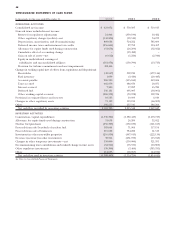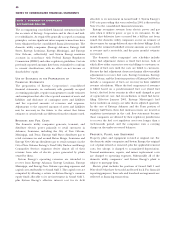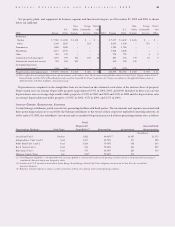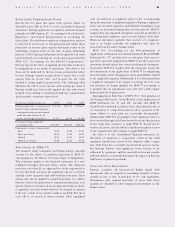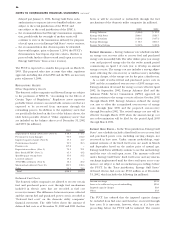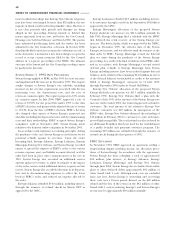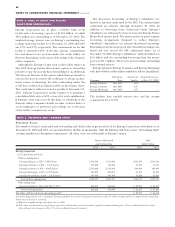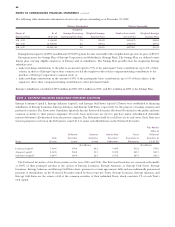Entergy 2002 Annual Report Download - page 58
Download and view the complete annual report
Please find page 58 of the 2002 Entergy annual report below. You can navigate through the pages in the report by either clicking on the pages listed below, or by using the keyword search tool below to find specific information within the annual report.
delayed past January 1, 2004, Entergy Gulf States seeks
authorization to separate into two bundled utilities, one
subject to the retail jurisdiction of the PUCT and
one subject to the retail jurisdiction of the LPSC.);
the recommendation that Entergy’s transmission organiza-
tion, possibly with the oversight of another entity, will
continue to serve as the transmission authority for purposes
of retail open access in Entergy Gulf States’ service territory;
the recommendation that decision points be identified
that would require, prior to January 1, 2004, the PUCT’s
determination, based upon objective criteria, whether to
proceed with further efforts toward retail open access in
Entergy Gulf States’ Texas service territory.
The PUCT is expected to consider this proposal on March 21,
2003. This proposal takes into account that other regulatory
approvals, including that of the LPSC and the SEC, are necessary
prior to January 1, 2004.
REGULATORY ASSETS
Other Regulatory Assets
The domestic utility companies and System Energy are subject
to the provisions of SFAS 71, “Accounting for the Effects of
Certain Types of Regulation.” Regulatory assets represent
probable future revenues associated with certain costs that are
expected to be recovered from customers through the
ratemaking process. In addition to the regulatory assets that
are specifically disclosed on the face of the balance sheets, the
table below provides detail of “Other regulatory assets” that
are included on the balance sheets as of December 31, 2002
and 2001 (in millions).
2002 2001
Department of Energy (DOE) fees (Note 9) $ 40.3 $ 47.5
Provisions for storm damages 93.9 214.0
Imputed capacity charges (Note 2) 17.3 41.7
Postretirement benefits 23.9 26.3
Pension costs 157.8 –
Depreciation re-direct (Note 1) 79.1 79.1
River Bend AFUDC (Note 1) 41.3 43.2
Spindletop gas storage lease 35.0 32.2
Low-level radwaste 19.4 –
1994 FERC settlement (Note 2) 12.1 20.2
Sale-leaseback deferral (Note 10) 123.9 128.3
Other 94.3 74.9
Total $738.3 $707.4
Deferred Fuel Costs
The domestic utility companies are allowed to recover certain
fuel and purchased power costs through fuel mechanisms
included in electric rates that are recorded as fuel cost
recovery revenues. The difference between revenues collected
and the current fuel and purchased power costs is recorded as
“Deferred fuel costs” on the domestic utility companies’
financial statements. The table below shows the amount of
deferred fuel costs as of December 31, 2002 and 2001 that has
been or will be recovered or (refunded) through the fuel
mechanisms of the domestic utility companies (in millions).
2002 2001
Entergy Arkansas $(42.6) $ 17.2
Entergy Gulf States $100.6 $126.7
Entergy Louisiana $(25.6) $(67.5)
Entergy Mississippi $ 38.2 $106.2
Entergy New Orleans $(14.9) $(10.2)
ENTERGY ARKANSAS – Entergy Arkansas’ rate schedules include
an energy cost recovery rider to recover fuel and purchased
energy costs in monthly bills. The rider utilizes prior year energy
costs and projected energy sales for the twelve month period
commencing on April 1 of each year to develop an annual
energy cost rate. The energy cost rate includes a true-up adjust-
ment reflecting the over-recovery or under-recovery, including
carrying charges, of the energy cost for the prior calendar year.
As a result of reduced fuel and purchased power costs in
2001 and the accumulated over-recovery of 2001 energy costs,
Entergy Arkansas decreased the energy cost rate effective April
2002. In September 2002, Entergy Arkansas filed and the
Arkansas Public Service Commission (APSC) approved an
interim revision to the energy cost rate effective October 2002
through March 2003. Entergy Arkansas reduced the energy
cost rate to offset the accumulated over-recovery of energy
costs through June 2002 and the projected over-recovery
through December 2002. The revised energy cost rate will be
effective through March 2003 when the annual energy cost
rate redetermination will be filed for the period April 2003
through March 2004.
ENTERGY GULF STATES – In the Texas jurisdiction, Entergy Gulf
States’ rate schedules include a fixed fuel factor to recover fuel
and purchased power costs, including carrying charges, not
recovered in base rates. Under current methodology, semi-
annual revisions of the fixed fuel factor are made in March
and September based on the market price of natural gas.
Entergy Gulf States will likely continue to use this methodology
until the start of retail open access. The amounts collected
under Entergy Gulf States’ fixed fuel factor and any interim
surcharge implemented until the date retail open access com-
mences are subject to fuel reconciliation proceedings before
the PUCT. In the Texas jurisdiction, Entergy Gulf States’
deferred electric fuel costs are $91.8 million as of December
31, 2002, which includes the following (in millions):
Interim surcharge $53.9
Items to be addressed as part of unbundling $29.0
Imputed capacity charges $8.6
Other $0.3
The PUCT has ordered that the imputed capacity charges
be excluded from fuel rates and therefore recovered through
base rates. It is uncertain, however, when or if a base rate
proceeding before the PUCT will be initiated. The current
56
NOTES TO CONSOLIDATED FINANCIAL STATEMENTS continued


